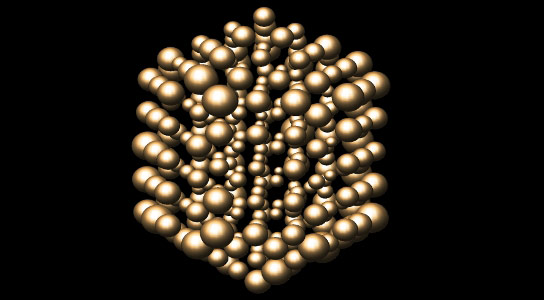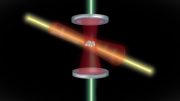
An illustration of the extent to which the atoms, in a small cluster of atoms, vibrate. The spheres represent the range of motion of the atoms, rather than the atoms themselves – the spheres have been exaggerated in size by 45 times in order to ease visualization. The atoms on the surface have larger ranges of motion than those in the middle of the cluster. Credit: University of York
Using new computer technology based on gaming machines, physicists were able to use a combination of molecular dynamics and quantum mechanics calculations to model the atomic vibration of individual atoms in nanomaterials.
Physicists at the University of York, working with researchers at the University of Birmingham and Genoa, have developed new technology to study atomic vibration in small particles, revealing a more accurate picture of the structure of atomic clusters where surface atoms vibrate more intensively than internal atoms.
Using new computer technology based on gaming machines, scientists were able to use a combination of molecular dynamics and quantum mechanics calculations to simulate the electron microscopy of gold particles. By modeling the atomic vibration of individual atoms in such clusters realistically, external atoms on the surface of the structure can be ‘seen’ to vibrate more than internal atoms. The research is published in the latest issue of Physical Review Letters.
Currently, electron microscopy only allows scientists to estimate the average position of atoms in a three-dimensional structure. This new technique means that, for the first time, the difference in individual atomic motion can also be considered, enabling more accurate measurements of an atom’s position and vibration in small particle structures.
This new development paves the way for a new field of dynamical study in the position dependence of atomic vibration in small particles, and is also likely to benefit the catalytical study of particles.
Richard Aveyard, Postdoctoral Research Associate in the Department of Physics at York, said: “Our work highlights the valuable contribution that computational simulations can have in the field of electron microscopy: the more details we can put into our simulations, the more details we can extract from experiments.”
Professor Jun Yuan, from York’s Department of Physics, added: “Our work can already explain the numerical discrepancies in the existing experimental data. We believe that it will also prompt new experiments focusing on the dynamical properties of the atoms at nanostructures, allowing us to understand the contribution of the previously little probed dynamical structure studies of atomic clusters, towards the physical properties such as catalytic relativities.”
Funded by the Engineering and Physical Sciences Research Council (EPSRC) and the European Cooperation in Science and Technology (COST), this research is part of an ongoing collaboration with the University of Birmingham and University of Genoa on three-dimensional structural studies of atomic clusters and nanoalloys.
Reference: “Modeling Nanoscale Inhomogeneities for Quantitative HAADF STEM Imaging” by Richard Aveyard, Riccardo Ferrando, Roy L. Johnston and Jun Yuan, 13 August 2014, Physical Review Letters.
DOI: 10.1103/PhysRevLett.113.075501









I impressed by the quality of information on this website. I am very enjoyed for this blog. Its an informative topic. Very useful info. I am sure I will visit this place again soon. Hope to see more posts soon!